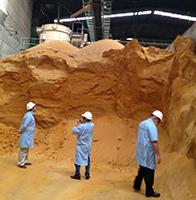The U.S. Grains Council (USGC) recently concluded its first 2015/2016 Corn Harvest Quality Report roll out in a tour of five cities in Southeast Asia during which more than 300 participants enthusiastically took notes and shared the data with their colleagues and counterparts.
“In my five years presenting the report, this is the most excitement I’ve seen even despite the region not importing U.S. corn,” said Kevin Roepke, regional director for Southern Asia, who oversaw the meetings, held in Ho Chi Minh City, Hanoi, Yangon, Bangkok and Jakarta.
Collectively, Southeast Asia has grown into a powerhouse for feed grain imports. As a whole, the region is expected to purchase more than 12 million metric tons (472 million bushels) of corn from global origins this year, which would surpassing Mexico’s corn imports and nip at the heels of the traditional global corn import leader, Japan. However, due to poor freight spreads and a strong U.S. dollar, the United States will most likely get very little of that business.
Corn-based feed products, on the other hand, are a different story. Vietnam alone was the third largest importer of U.S. distiller’s dried grains with solubles (DDGS) for the first 10 months of this calendar year and, collectively, the region may import almost as much as Mexico, the second largest U.S. DDGS importer. Additionally, Indonesia is the largest buyer of U.S. corn gluten meal, accounting for sales of almost 165,000 tons last calendar year.
“Buyers recognize it takes quality feed ingredients to make quality compound feed,” Roepke said. “They also recognize it takes high-quality corn to make high-quality DDGS. Sometimes, the best ingredient isn’t the lowest-cost ingredient, but rather one that you can extract the most value from.”
The Council demonstrated this during the corn quality rollout event and included information on prediction equations specifically designed for low-oil DDGS and presented by Dr. Gerald Shurson of the University of Minnesota and Dr. Budi Tangendjaja, USGC consultant in the region.
The presentation also included a new foray into DDGS promotion in the region’s aquaculture sector with an overview from Dr. Allen Davis of Auburn University and a DDGS market update from Hunter Kaestner and Joe Caruso of The Scoular Company.
“This event is just one example of the region’s shifting the focus from price to value,” Roepke said. “Knowing that your vessel will get loaded within the week; knowing that the corn is graded by non-biased government officials; and knowing that 100 percent of the samples tested below the U.S. Food and Drug Administration (FDA) action level for mycotoxins all have value.”
The Southeast Asian regional presentation of the corn quality report is one of many such happenings this month around the globe. A companion report, the 2015/2016 Corn Export Cargo Quality Report, will be available in the spring to help educate customers about the quality of U.S. corn as it is loaded for export.
Click here to view a PDF version of the Council’s 2015/2016 Corn Harvest Quality Report.


